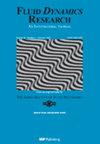椭圆叶片涡致自旋在盖驱动腔流中的数值研究
IF 1.3
4区 工程技术
Q3 MECHANICS
引用次数: 0
摘要
盖驱动腔中的大规模涡流是角动量的潜在来源,由于流体-结构的相互作用,角动量可以在自由旋转的惯性体中引起旋转效应。本研究的新目的是研究铰接在盖驱动腔中心的椭圆叶片的涡流诱导自转。采用迭代直接强迫浸没边界法对控制方程进行了数值求解。分析了雷诺数和叶片长度对叶片动力学特性的影响。考虑到水平顶盖的左右运动,确定了四种不同的涡流诱导模式作为稳定叶片响应,包括静止位置、小振幅颤振、顺时针自转和逆时针自转。长叶片大多有可能实现稳定的顺时针自转,特别是在雷诺数较高的情况下,因为与其他涡流相比,主要的近壁腔涡流占主导地位。相反,在短叶片中,中心逆时针涡流的有效作用以及这种叶片与近壁空腔涡流的弱相互作用导致了稳定的逆时针旋转,特别是在高雷诺数下。在雷诺数较低或叶片长度适中的情况下,涡流引起的叶片顺时针和逆时针方向的运动相当平衡,导致静止位置或小振幅颤振模式。本文章由计算机程序翻译,如有差异,请以英文原文为准。
Numerical study of vortex-induced autorotation of an elliptic blade in lid-driven cavity flow
Large-scale eddies in a lid-driven cavity are potential sources of angular momentum which can induce rotational effect in a free-to-rotate inertial body due to fluid–structure interaction. The novel objective of the present study is to investigate vortex-induced autorotation of an elliptic blade hinged at the centre of a lid-driven cavity. The governing equations are numerically solved using iterative direct forcing immersed boundary method. The impact of Reynolds number and blade length on dynamics characteristics of the blade are analysed. Considering left to right motion of horizontal top lid, four different vortex-induced modes are identified as the steady blade response, including stationary position, small-amplitude fluttering, clockwise autorotation and counter-clockwise autorotation. Long blades are mostly potential for steady clockwise autorotation, particularly in higher Reynolds numbers, due to dominance of principal near-wall cavity vortex compared to other vortices. In contrast, effective role of central counter-clockwise vortex in a short blade and weak interaction of such blade with the near-wall cavity vortex leads to a steady counter-clockwise rotation, particularly in high Reynolds numbers. In the case of low Reynolds numbers or blade with moderate length, vortex-induced blade motions in clockwise and counter-clockwise directions are fairly balanced, leading to stationary position or small-amplitude fluttering modes.
求助全文
通过发布文献求助,成功后即可免费获取论文全文。
去求助
来源期刊

Fluid Dynamics Research
物理-力学
CiteScore
2.90
自引率
6.70%
发文量
37
审稿时长
5 months
期刊介绍:
Fluid Dynamics Research publishes original and creative works in all fields of fluid dynamics. The scope includes theoretical, numerical and experimental studies that contribute to the fundamental understanding and/or application of fluid phenomena.
 求助内容:
求助内容: 应助结果提醒方式:
应助结果提醒方式:


